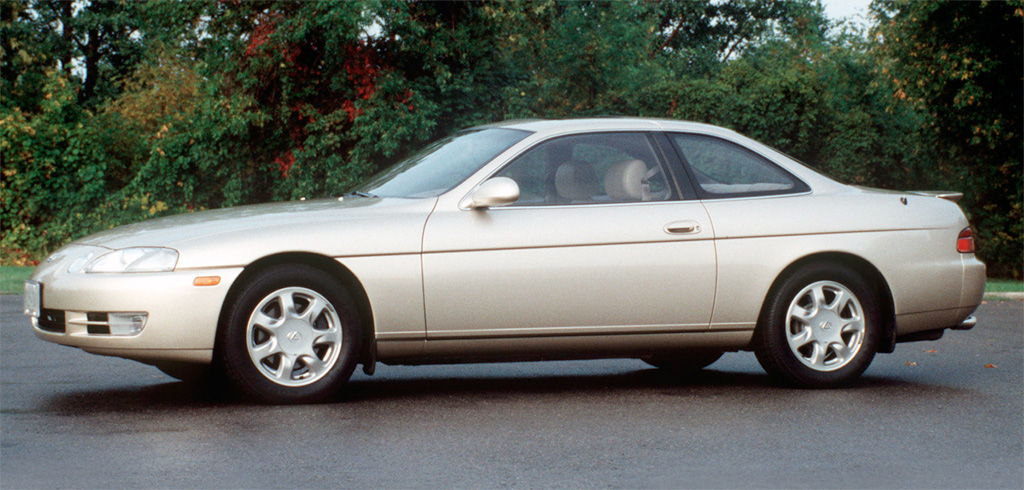Why aren’t 1992-2000 Lexus SC 300/400s worth more?
Before long, cars from the 1990s will be as collectible as those from the 1960s. A number of short-run, highly individual models superseded the boxy 1980s and the key change came in 1990.
The Chevrolet Corvette ZR-1 paved the way for sports cars, boasting 375 bhp from a 32-valve double overhead-cam (DOHC) Lotus-designed V-8 engine, and a top speed of 175 mph. Toyota astonished the American luxury market (and disappointed Mercedes-Benz and BMW) by introducing the 1990 Lexus LS400 V-8 sedan, capable of 150 mph in reliable serenity.
Lexus didn’t rest, launching the high-po SC400 luxury coupe in 1992. Both models showcased elegant controlled lines, with low coefficients of drag and they were both powered by a fuel-injected 4.0-liter, 250 bhp DOHC V-8. Car and Driver timed the SC400 to 60 mps in 6.7 seconds.
Luxury fitments included a four-speed automatic transmission; power disc anti-lock brakes; power steering, seats and windows; door locks with remote; air-conditioning; cruise control; leather interior and even an optional factory radar detector. The SC400 coupe succeeded in the niche grand tourer market selling 19,212 units in 1992.
Part way through the 1992 model year the $32,000 SC300 coupe was launched, with a three-liter, 225 bhp, DOHC six-cylinder engine, also found in the Toyota Supra. Not nearly as popular, the SC300 automatic still recorded 7,074 sales the first year, and a rare five-speed manual gearbox option added 1,601 more units. The five-speed would be offered through 1997, but never found many takers, with only 3,883 built in total. Needless to say, these are hard to find today. For the record, only one SC400 was built with a five-speed, for Jim Press, the President of Toyota North America at the time.
Twenty-five years later a surprising number of SC400/300 models survive. This is partly due to the initial buyers’ nature. They were mostly upper-middle income, middle-aged or older Japanese car loyalists. They had grown used to dependable Toyotas and were buying the best leather LazyBoy recliner they could find, planning to keep it indefinitely. Those who leased and flipped their cars every three years were disappointed. As a realtor friend said in exasperation: “I sold my Lexus after five years with 180,000 miles on it, and the damn thing is STILL running around town.”
The SC coupes, with their long hood, sloping windshield and short deck have worn well aesthetically. But their very nature seems to be working against them in the market. They’re very dependable and smooth, but lack a 50-year heritage like the Chevrolet Corvette, Mercedes-Benz SL or Porsche 911. Worse still, most period automotive journalists confused Japanese reliability with soullessness, a notion that still poisons Asian cars’ collectability for some.
All of those emotional arguments aside, ironically, it’s the cheaper SC300, equipped with a five-speed manual, which is currently the most desirable SC. This is because a manual Lexus SC300 is essentially a luxury-spec Toyota Supra; a fact not lost on the tuner market, hence the difficulty in finding an unmolested five-speed. Yet all SCs are presently at the bottom of their price curve. Good eary-‘90s cars can be picked up for $5,000 or so and if they have been maintained, 200,000 miles is no big concern. However once repairs are necessary, the equation goes wrong quickly. Expensive cars have expensive parts. If there is no aftermarket – and there is little for luxury cars – dealerships can be frighteningly expensive.
Since SCs are barely on the collectible radar, wrecking yards have little call for parts, so they don’t save many cars. It’s a vicious cycle – at least for now. Few aftermarket parts, few cars in wrecking yards. So if you want an SC400 or SC300 (especially the five-speed version) you must buy the best car you can find. Preferably one-owner and with all available records.
In fairness, the SC400 and SC300 have a spectacular record for reliability and even replacing a timing belt won’t break you. For example: ever wonder where all the Infiniti Q45s went? Timing chain tensioners and chain should be replaced around the 100,000 mark. That’s an extremely involved job, and can cost as much as $5,000. Considering that the very best 1990s Q45 costs that much in first class shape, the risks aren’t worth it.
Be mindful that when cars are cheap and parts are expensive, maintenance is frequently deferred. Buy the best car you can and pay for a pre-purchase inspection. It will be money well spent if you can overlook a currently unsexy nameplate and lack of heritage. The right car should still be running when SCs appreciate.


